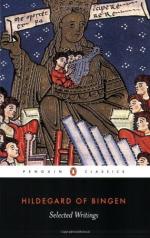|
This section contains 1,298 words (approx. 5 pages at 300 words per page) |

|
HILDEGARD OF BINGEN. Few medieval figures enjoy as much popularity in the contemporary Western world as the German Benedictine abbess Hildegard of Bingen (1098–1179). Her influence reflects the combination of authentic discovery and creative misreading that so often characterizes modern appropriations of religious figures from history. She appears in some ways to be very much a twelfth-century phenomenon in her rationalistic optimism, her persistent interest in questions of cosmology, and her openness to the use of art in the service of theological truths as well as her exaltation of virginity and assertion that women are the weaker sex. Hildegard was a visionary, a theologian, a musician, and a correspondent of popes and princes. She founded two religious houses for women and undertook a number of preaching tours.
In her theological writings Hildegard felt able to explore distinctively feminine aspects of the revelation, which is apparent...
|
This section contains 1,298 words (approx. 5 pages at 300 words per page) |

|


